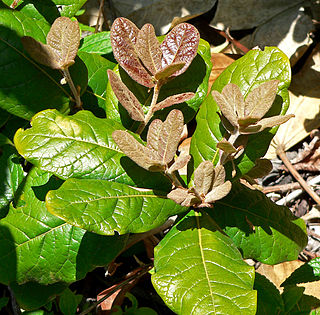
The Araceae are a family of monocotyledonous flowering plants in which flowers are borne on a type of inflorescence called a spadix. The spadix is usually accompanied by, and sometimes partially enclosed in, a spathe. Also known as the arum family, members are often colloquially known as aroids. This family of 140 genera and about 4,075 known species is most diverse in the New World tropics, although also distributed in the Old World tropics and northern temperate regions.

The Scrophulariaceae are a family of flowering plants, commonly known as the figwort family. The plants are annual and perennial herbs, as well as shrubs. Flowers have bilateral (zygomorphic) or rarely radial (actinomorphic) symmetry. The Scrophulariaceae have a cosmopolitan distribution, with the majority found in temperate areas, including tropical mountains. The family name is based on the name of the included genus Scrophularia L.

Plantaginaceae, the plantain family, is a large, diverse family of flowering plants in the order Lamiales that includes common flowers such as snapdragon and foxglove. It is unrelated to the banana-like fruit also called "plantain." In older classifications, Plantaginaceae was the only family of the order Plantaginales, but numerous phylogenetic studies, summarized by the Angiosperm Phylogeny Group, have demonstrated that this taxon should be included within Lamiales.
Dysopsis is a genus of plants in the family Euphorbiaceae, first described in 1858. It is the sole genus in subtribe Dysopsidinae. The genus is native to Costa Rica, Panama, South America, and the Juan Fernández Islands.
- Dysopsis glechomoides(A.Rich.) Müll.Arg. - Chile, S Argentina
- Dysopsis hirsuta(Müll.Arg.) Skottsb. - Juan Fernández Islands
- Dysopsis paucidentata(Müll.Arg.) Lozano & J.Murillo - Costa Rica, Panama, Colombia, Venezuela, Ecuador, Peru, Bolivia

Cyclanthaceae is a family of flowering plants.

Calyptrogyne is a genus in the palm family (Arecaceae). The distribution of this genus is Central America, Colombia, and southern Mexico, with 11 of the 17 known species endemic to Panama. Calyptrogyne ghiesbreghtiana is the most widespread and best studied species in this genus.

Quercus costaricensis is a species of oak native to Central America. It is often found with Quercus copeyensis in the upper montane forests, to 3,100 metres elevation. The leaves are tough and leathery with a short petiole and toothed margin. Wind is the primary pollinator. Squirrels are their main seed predator but also their main disperser as they commonly lose their buried seeds.

Linderniaceae is a family of flowering plants in the order Lamiales, which consists of about 25 genera and 265 species occurring worldwide. Vandellia micrantha is eaten in Laos, but tastes bitter. Best known are the wishbone flowers Torenia fournieri and Torenia thouarsii, which are used as bedding plants especially in the tropics. Micranthemum is sold as an aquarium plant when it is called 'baby tears'.
Philcoxia is a genus of seven rare plant species in the Plantaginaceae that are endemic to Brazil and resemble terrestrial species of the genus Utricularia. The genus, formally described in 2000, consists of the species P. bahiensis, P. goiasensis, P. minensis, P. tuberosa, P. rhizomatosa, P. maranhensis and P. courensis, each of the first three named for the Brazilian state to which it is endemic. The species are characterized by subterranean stems, peltate leaves at or below the soil surface, and five-lobed calyces. Their habitat has been reported as areas of white sand in the midst of cerrado vegetation at an elevation between 800 and 1450 m. Initial descriptions of the genus included suspicions that the plethora of stalked capitate glands on the upper surfaces of leaves was an indication that these species may be carnivorous. A study published in 2007 tested P. minensis for protease activity, a typical test for the carnivorous syndrome, and could detect none. Later studies detected other digestive enzymes such as phosphatases and qualitatively assessed prey digestion and nutrient uptake, suggesting that it is a true carnivorous plant. The genus epithet honors David Philcox (1926-2003), a botanist at Kew Gardens who worked extensively in tropical Scrophulariaceae.

Welfia is a genus of palms found in Central America and northwestern South America. Only two species are currently recognized: Welfia regia and Welfia alfredii.

Warmingia is a genus of orchids belonging to the subfamily Epidendroideae within the family Orchidaceae. It has four species, native to South and Central America.

Lepidobotryaceae is a family of plants in the order Celastrales. It contains only two species: Lepidobotrys staudtii and Ruptiliocarpon caracolito.

Coelia macrostachya is a species of orchid. It is native to Chiapas, Guatemala, Honduras, El Salvador, Panama, Guerrero, Oaxaca, Veracruz.

Warrea is a genus of flowering plants from the orchid family, Orchidaceae. It has three known species, all native to Latin America.
Solenocentrum is a genus of flowering plants from the orchid family, Orchidaceae. It is native to southeastern Central America and northwestern South America, from Costa Rica to Bolivia.

Persicaria punctata is a species of flowering plant in the knotweed family known by the common names dotted smartweed and dotted knotweed.

Dr Maarten Joost Maria Christenhusz is a Dutch botanist, natural historian and photographer.
Chorigyne is a genus of plants first described as a genus in 1989. All the known species are native to Costa Rica and Panama.

Xyris jupicai, common name Richard's yelloweyed grass, is a New World species of flowering plants in the yellow-eyed-grass family. It is widespread in North America, South America, Mesoamerica, and the West Indies.

Digitalis lamarckii is a species of flowering plant in family Plantaginaceae that is native to Turkey.
















